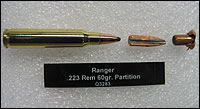
Mr. A. Nonymous tossed a bit of intel over my electronic transom this morning:
"FYI and it may or may not be significant-
The Feds, probably multiple departments combined, just let a contract for about 745K 223 barrier penetration rounds. These rounds are not used by DOD."
The rounds Mr. Nonymous is referring to are the Winchester Ranger 60 grain Partitions, Q3238, pictured above. This is the FBI standard issue load. According to sources, my own and Internet forums, the current back-order time for this is about one year. State and local police departments who standardized on it cannot obtain it for love nor money.
Depending upon the priority assigned to this contract by the agency, this order could now be slipped in line ahead of all other backorders. As the tip did not come with an open source provenance, I am unable to say which agency let this contract. The round itself was first adopted as standard with the Fibbies in August of 2005, according to this announcement at the time at PoliceOne.com:
Winchester® Wins Multiple Awards for Duty and Training .223 Ammunition for the FBI
Winchester Ammunition has recently won the competition for .223 duty and training ammunition for the Federal Bureau of Investigation. In order to meet the tough standards established by the FBI for their duty ammunition, Winchester collaborated with Nosler® and used their outstanding .223, 60 grain Partition® Bullet. This high performance bullet coupled with Winchester's stringent loading capabilities provided the best balance between penetration, expansion and retained weight through all of the barriers in the tough FBI Barrier Testing. . . This New Winchester Ranger® Partition product will be available soon to all Law Enforcement Agencies under the symbol Q3283.
Mr. Nonymous also kindly provided this link from LawOfficer.com, which discusses an evaluation test of the Q3283 and competitors.
The Ammunition Factor
Choosing ammo for your patrol rifles
Jeff Chudwin
Law Officer Volume 4 Issue 11
2008 Nov 20
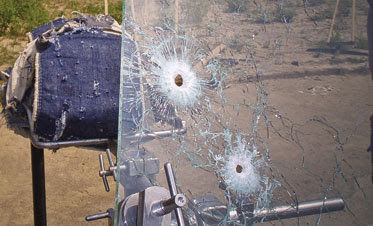 Patrol rifle ammo must be able to punch through auto glass and heavy clothing to incapacitate offenders. (Photos Jeff Chudwin)
Patrol rifle ammo must be able to punch through auto glass and heavy clothing to incapacitate offenders. (Photos Jeff Chudwin) Recent events call for a review of the choice of street ammunition for the police patrol rifle. Why concern ourselves with such specialized information? A bullet is a bullet, and if we do our part in terms of aimed fire, what difference does it make?
Answer: It can mean the difference between winning and losing the fight for life.
As Sergeant Phil Messina (NYPD ret.) of the Modern Warrior training group has taught us, you have only so much time in a fight to do something productive to defend your life and stop the threat. In that wedge of time, your actions will either prove effective, or you allow the offender the opportunity to use that time against you.
As Messina so ably teaches, you can't buy time back in a fight. This is why we must not make choices in tactics and gear that relinquish time to the offender.
In several recent gunfight incidents, the ammo chosen for the patrol rifle mission was reportedly unable to penetrate the sheet metal or glass of the offender's auto and effectively strike the criminal shooter. The bullet came apart after hitting metal and glass, and the remaining fragments had no effect in stopping the attack.
Not surprising, because the officer was using ammunition that wasn't designed for this type of fight.
A number of bullet designs address different tactical needs, and the street fight requires barrier penetration. Firing multiple rounds at the active shooter with no effect due to the wrong choice of ammunition is an example of the time vs. effect equation as taught by Messina. Critical time and opportunity was lost to no good effect, and the gunman continued to fire on officers.
As the training cadre for Illinois' Mobile Training Unit #3, we demonstrate this point in every Patrol Rifle Instructor class we conduct. Using the IWBA/FBI ballistic gelatin protocols, we shoot various bullet types against multiple barriers so officers running their agency's firearms training gain a first-hand understanding of terminal ballistic performance. Most have never seen this testing nor even know of its existence. Using barriers that range from heavy clothing and soft body armor to auto glass and sheet metal, testing either validates the ammo choice or shows why it will fail at the most vital moment.
Other than testing in some consistent and validated manner, how is duty ammunition chosen, and by whom? In some cases, the department's choice was made by those in command who lack ballistic knowledge and expertise but were convinced they must avoid excess penetration due to liability concerns. Of course, the greatest liability is officers and citizens exposed to gunfire without officers having the means to put an end to it. Knowingly choosing less-effective ammunition due to unfounded fears is the same as setting up patrol cars so that officer's speed is restricted to 50 mph. It makes no sense.
As revealed by extensive testing of police-duty ammunition by the FBI, the vast majority of .223-caliber ammo fails to make anywhere near the penetration level needed to deliver effective wounding capability across all testing parameters. With lightweight varmint-type bullets, this is true where no intervening barrier exits other than clothing or even bare skin.
Considering that many of the deadly force events that take place involving patrol and SWAT occur on the street, we must focus on equipping officers with ammunition that's ballistically effective in overcoming violent offenders located in and around autos. The bullet must defeat the barrier in front of the shooter, not fragment and break into lightweight pieces, and retain sufficient velocity to penetrate and strike vital organs and blood vessels deep in the offender's body, causing immediate or rapid incapacitation.
Making the Choice
To determine what you need, you must know what you want. Consider where and under what conditions you expect to meet deadly force threats. Then study the information from the ammunition manufacturers and FBI.
For this review, I will focus on the most common patrol-rifle caliber, the .223 Remington (also designated 5.56mm by the military.) This is the caliber of choice nationwide and has been used by the military since the mid-1960s.
Common .223/5.56mm bullet loads range from 40–77 grains and come in a number of designs. Unlike the military, law enforcement isn't restricted by bullet type. We can choose between full metal jacket, hollow point, soft point, frangible or open tip match. Of those choices, we can choose from bullets designed with light jackets and soft lead cores, or the type classified as barrier penetrators with tough jackets and hard lead-alloy cores or a single formed alloy.
The difference is vital for the police mission. Light-construction bullets universally fail to get through intervening barriers such as sheet metal and glass with sufficient bullet weight remaining to have any effective wounding capability.
Penetration into ballistic gel by bullet fragments of very light weight seldom see the fragments go deeper than 5–6 inches. The photo on the left shows what looks like a shotgun blast to the face of the ballistic gel block. In fact, it's the result of firing a Hornady TAP round through auto glass. This fragment spread is typical of the lack of penetration performance from any of the traditional 55-grain soft or hollow-point .223-caliber bullets after striking a hardened surface such as tempered auto glass.
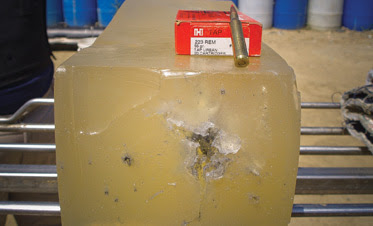 .223 Remington
.223 Remington In its written materials ( www.hornadyle.com/_img/hornady_tap_report.pdf ) Hornady describes its 55- and 60-grain TAP rounds as offering "rapid expansion, high fragmentation, and low retained weight." Their description is on the money, and when an officer needs reduced penetration, this may be the right choice. It's not what you need on a street mission, however.
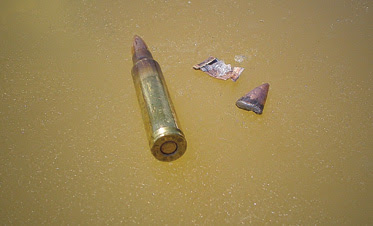 XM-193
XM-193Full metal jacket types such as the 55-grain XM-193 do somewhat better, but as seen above, they also break apart on impact with bare gel. On sheet metal and auto glass, we recovered only small fragments.
In contrast to the above, bullets designed as barrier penetrators feature heavy construction in the jacket and core, and they penetrate barriers much better. I'll briefly discuss four examples below.
Corbon Barnes X www.dakotaammo.net/lawenforcement/law.htm
Corbon now offers its new Barnes X solid-copper bullet into both their 53 and 62 grain .223 barrier penetrator loadings.
Photo X shows this bullet after penetrating auto glass, heavy clothing and more than 15 inches on ballistic gelatin. Retained weight was 49 grains of the original 53, and the bullet expanded from .223 caliber to .35 caliber. This is superior bullet performance.
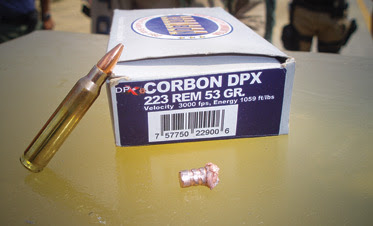 Corbon Barnes X www.dakotaammo.net/lawenforcement/law.htm
Corbon Barnes X www.dakotaammo.net/lawenforcement/law.htm Federal Tactical http://le.atk.com/general/federalproducts/rifle/tacticalbonded.aspx
The FBI protocols call for penetration of 12 inches or greater to insure highest wounding capability. The Federal Tactical bonded .223 round in both 55- and 62-grain has been in used for a number of years by both federal and municipal agencies. Using a proprietary technology, the bullet core and jacket are bonded or fused together.
This offers significantly better terminal performance than traditional soft-point bullets that may look identical in form but come nowhere close in performance.
Both the 55- and 62-grain Tactical penetrated the auto glass, heavy clothing and 16 inches of ballistic gel with a retained weight of 49 grains and better, expanding as shown. Again, top performance.
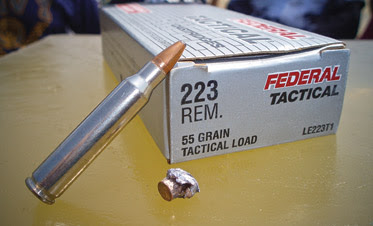 Federal Tactical http://le.atk.com/general/federalproducts/rifle/tacticalbonded.aspx
Federal Tactical http://le.atk.com/general/federalproducts/rifle/tacticalbonded.aspx Winchester Nosler Partition www.winchester.com/lawenforcement/catalog/cfrifle.aspx
Winchester uses a 60-grain Nosler Partition for its .223-caliber barrier penetrator that is in use by the FBI. As seen in the photo, it also performs well against intervening barriers. The bullet defeated the auto glass and light clothing, penetrated more than 17 inches and retained more than half its weight.
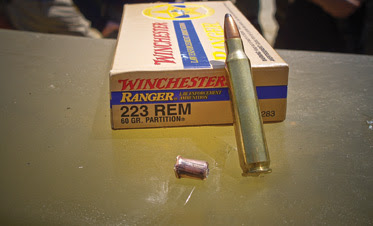 Winchester Nosler Partition www.winchester.com/lawenforcement/catalog/cfrifle.aspx
Winchester Nosler Partition www.winchester.com/lawenforcement/catalog/cfrifle.aspx Hornady Barrier Penetrator www.hornadyle.com/_img/hornady_tap_report.pdf
Hornady makes a 62-grain barrier penetrator as seen in the photo. Unlike its 55- and 60-grain TAP round that are constructed of a light jacket and soft core, this bullet drove deeper with greater retained weight. Still, it didn't perform as well as the others we tested.
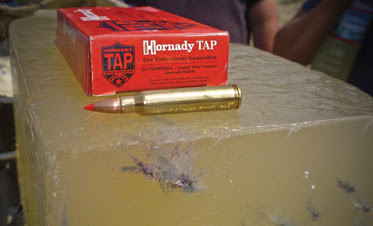 Hornady Barrier Penetrator www.hornadyle.com/_img/hornady_tap_report.pdf
Hornady Barrier Penetrator www.hornadyle.com/_img/hornady_tap_report.pdf Conclusion
Any .223-caliber cartridge using a varmint-type bullet is not the choice to use on the street where the fight will likely involve autos and other hard barriers. The penetrator rounds pictured above are not the only ones made, but they're a good representation of what's available. Any one of these will provide a significant upgrade for the street officer. Define the mission and environment most likely faced by your officers. Then choose the bullet best designed for that mission, and go forward with knowledge and confidence.
Jeff Chudwin serves as chief of police for the Village of Olympia Fields, Ill. A founding member and current president of the Illinois Tactical Officers Association and co-chairman of the Illinois Law Enforcement Alarm System Region 4, Chudwin is a former assistant state's attorney and has been a firearms, use-of-force and emergency response trainer for more than 25 years. Contact him at lawofc400@aol.com.
The FBI's Test Info
If you want to see the FBI's testing data on police-duty ammunition, order it from the agency's test facility. Your order must be on official letterhead and come from a department supervisor.
FBI Ammunition Test Facility
Quantico, VA
Tel. 703/640-1386
Chudwin's Rankings
Based on our testing, I rank the barrier penetrators as follows:
Corbon DPX
Federal Tactical Bonded
Winchester Partition
Hornady Barrier Penetrator
********************************************
In January, DocGKR, writing at M4Carbine.net, here commented:
The Winchester 60 gr JSP Nosler Partition (Q3283) load is the current FBI .223 load. In addition to the Winchester product, Black Hills also does a very nice loading of the 60 gr Nosler Partition. The previous load was the Federal 62 gr JSP TBBC (LE223T3) loading. All are reasonably good .223 barrier loads, with an advantage to the Federal Tactical bonded loads in both 62 gr, as well as the 55 gr load (LE223T1 or identical P223T2). Another option would be the Hornady 62 gr JSP TAP Barrier load. The Swift 75 gr Scirrocco and various Barnes TSX loading in 45, 53, 62, and 70 gr weights are also good projectiles. We are also in the process of testing the new 64 gr Speer Gold Dot JSP and the new 62 gr Remington bonded JSP loads, as they show good promise.
Keep in mind, that with non-fragmenting bullet designs, heavier bullet weights are not necessarily better, especially at closer ranges and from shorter barrels. As long as penetration and upset remain adequate, it is possible to use lighter weight non-fragmenting bullets and still have outstanding terminal performance. With fragmenting designs, a heavier bullet is ideal, as it provides more potential fragments and still allows the central core to have enough mass for adequate penetration. In addition, heavier bullets may have an advantage at longer ranges due to better BC and less wind drift.
Insofar as the 745,000 rounds are concerned, the FBI uses another "green" round for training. Q3283's are used strictly for anti-social work. Grist for the bloody mill.
Mike
III
14 comments:
DAAMMMNNNN!!
No wonder everyone has the misunderstanding of the 5.56 as being a light-weight ammo.
Is any of this penetrator ammo available to us civilians? Or is it for LEO's & military only??
B Woodman
III
Not good. A sure sign that our loving Gov't is preparing for the worst. As well we should too.
Pickdog
III
that glass needs replacement! I reckon! lolz try Auto Glass Repair
Excuse me for not being paranoid, but don't we want our government to have the finest ammunition available?
This is 24,833 30-round magazines full. Sure that's a lot. Unless you are buying for the next decade or two of normal use. How many rounds do they routinely fire in the course of doing "business" with they types of people that we do want shot each year?
. . . and who's to say this is even going to stay in FBI hands, and not be funneled to another organization where such a purchase would raise eyebrows (say, in South America)?
. . . also (and I consider this more likely) whose brother in-law works at the plant that makes this ammunition?
Much of the ammo we use is in short supply, especially penetrating rounds. For the reloaders you can still load your own if you can locate a supply of "pulled" tracer ammo. These typically have the penetrator tip inside the jacket and there are several methods to deactivate the "tracer" function if desired. Some may ask why a civilian would need this type of ammo. One of the main reasons we were not attacked on the mainland during WWII was the fear of the armed American. WE are the last line of defense for our country.
Weaver
The answer to .223 is .308
.223 is for shooting coyotes and p-dogs.
Cory
Don't want to rain on anyones parade or opinion, but having killed a number of people with an AR-15 using 55gr. cartridges, it gets the job done. Of course, the heavier ones will penetrate more and do a better one. But you go ahead and do what you want to do, with any .308. Good guns, good round. By the time you drink your fifth quart of water before noon, you're going to understand what each ounce of weight does to you as you march to an engagement, or participate in one. If you got the stuff, go for it. Just one other thing. Refills for your canteen, five-quart, two quart, camel-back, whatever, might not be handy when you want,or need them.
I don't want "my government" to have ANY ammo at all. If they need guns there are plenty of HONEST people who can provide the appropriate firepower without killing the wrong people.
I wonder if the folks who work at the ammo plants ever think about the irony that the ammo they are making for the gov will probably be used against them someday soon.
Most, if not all, the "penetrator" rounds listed in the article, were developed for deer hunting with the 223. They were "on the shelf" prior to the Obamnation.
7.62x54R heavy ball will go through 1/2" plate....
Sean, .308, or 7.62x 54R will do a creditable job. If they get too heavy to carry, you can always use them to convert an enemy into a supply sergeant with lighter equipment.
Straightarrow, that goes back to the discussion about a lifetime supply of ammunition. As I recall, the answer ended up "20rds. + what the other guy was carrying."
Sean, if it didn't work we wouldn't have used it 40 years with no apparent plans to stop.
Great information...
As far as the contract is concerned, it sounds like a lot until you consider that it works out to just 745 cases.
If they train with what they use, that makes it a smaller number still.
A month or two ago a distributor could sell out of that quantity in mere hours or days.
Mike-
I'm not sure if you have seen this other "Ammo Factor" yet. It backs up the (slow twist) 223 (deer load) barrier idea and more. Yea, I know about the bitching it will cause when most look at their stock pile with nothing but .mil ball in it and no way now to add to it.
Please see:
http://ammo.ar15.com/project/Self_Defense_Ammo_FAQ/index.htm
A. Nonymous
Post a Comment